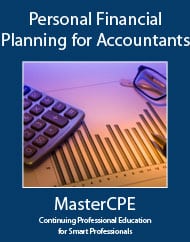Course Information
Personal Financial Planning for Accountants
Course Information
| Title: | Personal Financial Planning for Accountants |
|---|---|
| Category: | Finance |
| Field of Study: | Finance |
| Course Code: | M293 |
| CPE Credits: | 18.0 |
| Price: | 103.95 |
Description
Description:
Personal Financial Planning for Accountants is a comprehensive course on personal finance. What is more important to the “average person” than making sure their finances are secure using proper planning and money management? This course includes the major areas in personal financial planning – planning your personal finances, managing your personal finances, making your purchase decisions, insuring your resources, investing your financial resources, and controlling your financial future. Topics covered include time value calculations, budgeting, career planning, banking, insurance, home buying, consumer credit and money management, investment planning, retirement planning, and estate planning.
Delivery Method: Online Interactive Self Study
Level: Overview
Prerequisites: None
Advanced Preparation: None
Course Details
Category: Finance
Field of Study: Finance
Passing Score: 70%
Technical Details: Finance: Technical
For More Detail:
If you are unable to view PDF then right click the mouse and click save link as
Objectives
Objectives:
Chapter 1: What You Should Know About Financial Planning
- Recognize the personal financial planning process.
- Identify the objectives and key areas of personal financial planning.
- Recognize how the stages in life affect financial planning.
- Recognize how inflation and other economic factors affect financial planning.
Chapter 2: Time Value Applications
- Identify how the time-value of money affects financial decisions.
- Recognize the importance of future value tables.
- Recognize how to use different rules in financial decision making.
Chapter 3: Personal Financial Statements and Budgeting
- Recognize the balance sheet (net worth statement) for personal net worth.
- Identify the reasons for budgeting.
Chapter 4: Career Planning and Financial Success
- Recognize factors to consider in selecting a career.
- Identify employment benefits.
- Identify some work-at-home benefits.
Chapter 5: Planning for College Education
- Calculate how much money savings is required for a college education.
- Identify ways to finance college education.
- Identify sources of financial aid.
- Recognize Federal government programs.
Chapter 6: The Return and Risk of Your Investments
- Recognize risk and assess the risk-return trade-off.
- Recognize different investment vehicles and outline their risk-return characteristics.
- Identify different types of risk and ways to reduce overall risk.
Chapter 7: Banking and Cash Management
- Identify attributes of different short-terms investment vehicles.
- Identify different banking tools available.
- Recognize some of the banking regulations to help protect accounts.
Chapter 8: Managing Debt
- Recognize the different factors of credit ratings and FICO scores.
- Recognize various debt management strategies and debt/equity ratios.
- Identify aspects of bankruptcy law.
Chapter 9: How to Reduce the Costs of Living
- Identify ways to save on living costs.
- Recognize leasing decisions and rules.
Chapter 10: Where and How You Choose to Live
- Recognize factors to consider when deciding whether to buy or rent a home, and the different cost factors for housing and home financing.
Chapter 11: Life, Health, Property, and Liability Insurance
- Identify the types of risk that need to be protected.
- Identify a variety of life insurance policies and organizations.
- Recognize medical and health insurance coverage attributes and different policy attributes for property insurance.
Chapter 12: Investments and Planning
- Identify investment strategies and sources of investment money.
- Recognize the different risk factors for investments.
Chapter 13: Investing in Common Stock
- Identify the types of common stock and stock valuation methods using some practical approaches.
- Recognize ways to measure market-risk.
Chapter 14: Fixed-Income Securities and Real Assets
- Identify the terms and features of bonds, and the types of bonds and methods for selecting bonds.
- Calculate yield (effective rate of return) on a bond.
- Recognize differences between bonds and preferred stock and identify other fixed-income securities.
- Identify the pros and cons of investing in real estate and the types of real estate investments.
- Recognize factors to be considered regarding a real estate investment.
- Recognize indirect real estate vehicles such as real estate investment trusts (REITs) and limited partnerships.
Chapter 15: Funds and Diversification
- Recognize the attributes and types of mutual funds and ETFs.
Chapter 16: Retirement and Estate Planning
- Identify different types of retirement options.
- Recognize the steps to be taken for retirement planning.
- Recognize alternative options for meeting retirement financial requirements.
- Identify the objectives of estate planning.
- Recognize the purpose of different legal documents.
For More Objectives:
If you are unable to view PDF then right click the mouse and click save link as
Profession
NASBA: Yes
QAS: Yes
CPA: Suitable for all CPAs
IRS: No IRS credit for Enrolled Agents.
Profession Identifiers: CPA

